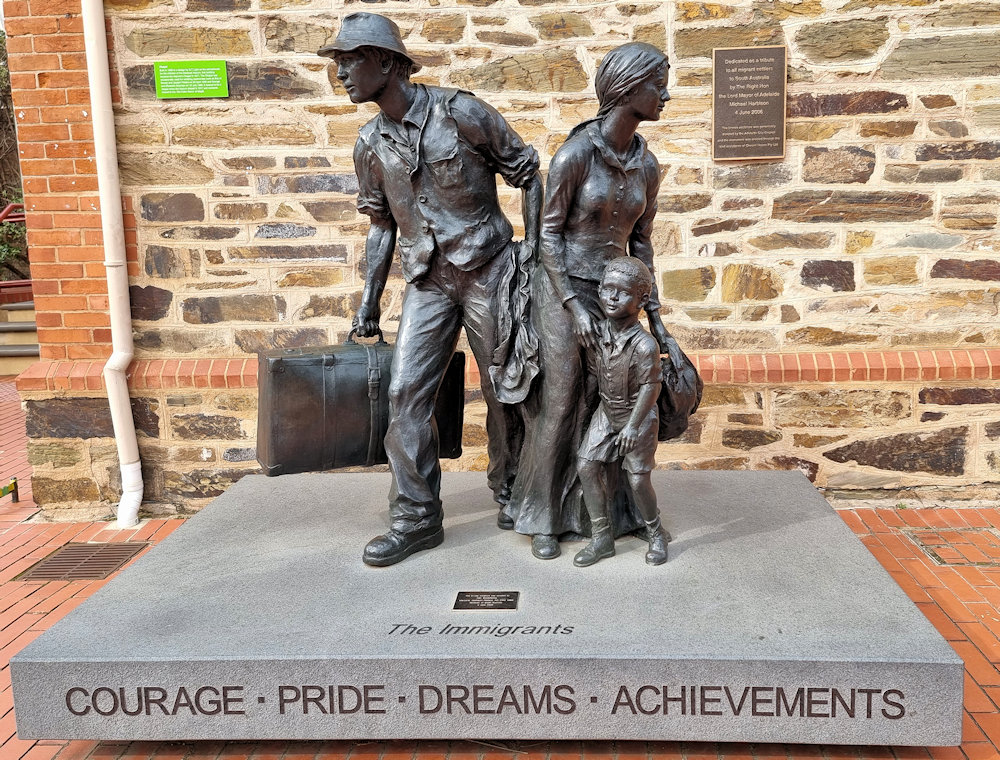Migration Museum Adelaide
The Migration Museum in Adelaide is a social history museum about immigration, settlement, and cultural change in South Australia. It is one of three museums operated by the History Trust of South Australia.
History

The museum stands as one of the state’s most significant cultural institutions. It tells the stories of people who have come from around the world to make South Australia their home. Established in 1983, it was Australia’s first museum dedicated to the history of immigration and settlement. The museum is located on Kintore Avenue, near North Terrace, within historic stone buildings once part of Adelaide’s colonial welfare complex.
Its creation reflected a growing recognition in the late twentieth century that migration shaped Australia’s identity. Free settlers, assisted immigrants, refugees, and others all contributed to the state’s development. During the rise of multiculturalism, government and community leaders saw a need to share migrant experiences. Many stories of hardship, hope, and achievement had been overlooked in traditional histories.

The museum’s goal was to celebrate diversity and show how migration shaped South Australia’s character. Through exhibitions, community projects, and oral histories, it shares experiences from over 100 cultural backgrounds. Exhibits highlight European arrivals, the impact of colonisation on Aboriginal people, and the journeys of post-war and recent migrants.
Displays use artefacts, photos, letters, and multimedia to tell personal stories of arrival and belonging. The museum welcomes many school groups and encourages reflection on identity and heritage. It promotes understanding and dialogue among people of all backgrounds.
The museum’s heritage-listed buildings date from the 1850s and once formed part of the Destitute Asylum. That earlier institution offered shelter to Adelaide’s poor. Today, the same walls house stories of endurance, community, and hope, linking the struggles of the past with those of modern migrants.


Adelaide Destitute Asylum
The Adelaide Destitute Asylum, was a government institution established in 1851 by the Destitute Board in South Australia. Its purpose was to provide “indoor relief” to those with no means of support: the poor, the homeless, the infirm, orphans, pregnant unmarried women, the elderly, people with disabilities, and others unable to provide for themselves.
The asylum was a product of the era’s moral and social attitudes, which viewed poverty as a personal failing but also as a social problem requiring institutional management. Conditions were austere, with residents living under strict rules and minimal comforts.
By the early twentieth century, the asylum system had declined, and the buildings were repurposed for other government uses. Today, the preserved Destitute Asylum building forms an evocative part of the Migration Museum’s setting. Visitors can still see the original women’s dormitory and other restored rooms, which provide a tangible link to the human hardship that once occurred there. Its presence serves as a poignant reminder of Adelaide’s early social welfare history and deepens the museum’s exploration of displacement, resilience, and the search for belonging across generations.
Perhaps most poignantly, between 1880 and 1909 1,678 babies were born in the Lying-in Home at the Destitute Asylum. The museum remembers these through memorial artworks and exhibitions, as well as with touch-screens and archival materials that bring forward some personal stories of those who lived in the Asylum. This institution reflects a more difficult side of migration, settlement, poverty, social welfare, and the evolving attitudes toward government care, gender, morality, and vulnerability in colonial and early federation era South Australia.

Visiting the Migration Museum & Destitute Asylum
Visiting the Migration Museum in Adelaide is a fascinating and moving experience. The museum sits on Kintore Avenue, surrounded by old stone buildings that once housed the Destitute Asylum. Its peaceful courtyard offers a moment to pause before stepping inside.
The galleries tell powerful stories about the people who have made South Australia their home. Exhibits explore early British settlement, post-war migration, and the experiences of refugees and recent arrivals. Every display invites you to connect with personal stories of struggle, hope, and belonging. Objects, letters, and photographs make the past feel close and real.
One gallery traces the journey of migrants from their homelands to Australia. It shows the challenges of leaving family and adapting to new cultures. Another examines the impact of migration on Aboriginal communities, encouraging reflection on colonisation and identity.
Interactive displays keep visitors engaged. You can listen to oral histories, explore digital archives, or share your own migration story. The museum’s small size allows time to read, reflect, and absorb each exhibit fully.
The outdoor areas retain much of the site’s historic character. Old stone walls and narrow walkways evoke the lives of those once housed in the Destitute Asylum. Nearby plaques explain how the buildings evolved from welfare institutions to a place of remembrance and learning.
The Migration Museum is free to enter, making it accessible to everyone. A visit usually takes about 30 minutes to an hour. It offers insight into South Australia’s multicultural heritage and the shared humanity behind every journey. Visiting the museum leaves you thoughtful, grateful, and more connected to Adelaide’s diverse story.
To find more things to see and do in South Australia, click here.

Leave a Reply